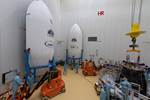Beyond Gravity delivers space technology, composites expertise for Artemis missions
Mechanisms to drive solar array panels, a composite universal stage adapter and central network electronics supply drive Artemis missions forward.
Beyond Gravity (formerly RUAG Space, Zürich, Switzerland) announces that it is part of the first three Artemis missions from NASA (Washington, D.C., U.S.), delivering important elements for the mission’s Orion spacecrafts, the Space Launch System (SLS) launch vehicles, as well as the planned Gateway space station. The company is one of many global composites suppliers that has supported the NASA Artemis missions.
“We are proud and honored to be part of these historic missions, contributing to the progress of humanity,” André Wall, CEO of Beyond Gravity, says. “Our employees in Switzerland, the U.S. and Austria have been developing, manufacturing and testing for the success of these missions for many years.”
Mechanisms from Beyond Gravity are to drive the mission’s solar wings. “Our mechanisms have to perform particularly complex and extremely precise movements to position the solar array panels correctly for all three Artemis missions. The work for this was done in Zürich, Switzerland,” Anders Linder, head of satellite business at Beyond Gravity, notes. According to the company, the mechanisms must make it possible to fold the solar array panels in such a way that they are not damaged when the propulsion system fires. This is primarily because the composites-intensive European Service Module (ESM) from prime contractor Airbus (Toulouse, France) has its own propulsion system.
In addition, Beyond Gravity’s expertise in carbon fiber composites manufacturing is helping to produce a large connector (universal stage adapter) that links the launch vehicle and the service module. The adapter is 9.9 meters high and 8.4 meters in diameter at its widest point. The adapter from prime contractor Dynetics (Beavercreek, Ohio, U.S.) will be used for the first time on the second Artemis mission.
“Work on this adapter started back in 2017 and was done at the U.S. facility in Decatur, Alabama. We did the design analysis and production at our plant in the U.S.,” Holger Wentscher, head of the launcher business at Beyond Gravity, adds.
Moreover, Beyond Gravity is working with its partner, TTTech (Vienna, Austria), to supply the central network electronics for the NASA Gateway, which will guarantee secure and reliable communications between Earth and the space station. U.S. satellite manufacturers Maxar (Westminster, Colo., U.S.) and Northrop Grumman (Falls Church, Va., U.S.) will integrate the products into the gateway, which will orbit the moon as a manned space station at a distance of more than 400,000 kilometers from Earth and serve as a stopover for astronauts and spacecraft.
Related Content
-
Novel dry tape for liquid molded composites
MTorres seeks to enable next-gen aircraft and open new markets for composites with low-cost, high-permeability tapes and versatile, high-speed production lines.
-
Materials & Processes: Composites fibers and resins
Compared to legacy materials like steel, aluminum, iron and titanium, composites are still coming of age, and only just now are being better understood by design and manufacturing engineers. However, composites’ physical properties — combined with unbeatable light weight — make them undeniably attractive.
-
Cryo-compressed hydrogen, the best solution for storage and refueling stations?
Cryomotive’s CRYOGAS solution claims the highest storage density, lowest refueling cost and widest operating range without H2 losses while using one-fifth the carbon fiber required in compressed gas tanks.

















